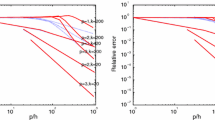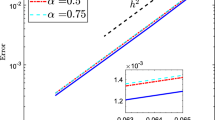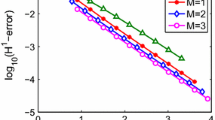Abstract
The aim of this paper is to carry out a rigorous error analysis for the Strang splitting Laguerre–Hermite/Hermite collocation methods for the time-dependent Gross–Pitaevskii equation (GPE). We derive error estimates for full discretizations of the three-dimensional GPE with cylindrical symmetry by the Strang splitting Laguerre–Hermite collocation method, and for the d-dimensional GPE by the Strang splitting Hermite collocation method.
Similar content being viewed by others
References
W. Bao, J. Shen, A fourth-order time-splitting Laguerre–Hermite pseudo-spectral method for Bose–Einstein condensates, SIAM J. Sci. Comput. 26, 2010–2028 (2005).
W. Bao, D. Jaksch, P.A. Markowich, Numerical solution of the Gross–Pitaevskii equation for Bose–Einstein condensation, J. Comput. Phys. 187, 318–342 (2003).
N. Ben Abdallah, F. Castella, F. Méhats, Time averaging for the strongly confined nonlinear Schrödinger equation, using almost-periodicity, J. Differ. Equ. 245, 154–200 (2008).
J. Bergh, J. Löfström, Interpolation Spaces, An Introduction (Springer, Berlin, 1976).
M.M. Cerimele, M.L. Chiofalo, F. Pistella, S. Succi, M.P. Tosi, Numerical solution of the Gross–Pitaevskii equation using an explicit finite-difference scheme: an application to trapped Bose–Einstein condensates, Phys. Rev. E 62, 1382–1389 (2000).
E. Faou, Geometric Numerical Integration and Schrödinger Equations (European Math. Soc., Zürich, 2012).
A. Friedman, Partial Differential Equations (Holt, Rinehart and Winston, Inc., New York, 1969).
L. Gauckler, Convergence of a split-step Hermite method for the Gross–Pitaevskii equation, IMA J. Numer. Anal. 31, 396–415 (2011).
E. Gross, Structure of a quantized vortex in boson systems, Nuovo Cimento 20, 454–477 (1961).
B. Guo, J. Shen, C. Xu, Spectral and pseudospectral approximations using Hermite functions: application to the Dirac equation, Adv. Comput. Math. 19, 35–55 (2003).
B. Guo, L. Wang, Z. Wang, Generalized Laguerre interpolation and pseudospectral method for unbounded domains, SIAM J. Numer. Anal. 43, 2567–2589 (2006).
E. Hairer, S.P. Nörsett, G. Wanner, Solving Ordinary Differential Equations. I. Nonstiff Problems, 2nd edn., Springer Series in Computational Mathematics, vol. 8 (Springer, Berlin, 1993).
E. Hansen, A. Ostermann, Exponential splitting for unbounded operators, Math. Comput. 78, 1485–1496 (2009).
B. Helffer, Théorie spectrale pour des opérateurs globalement elliptiques, Astérisque, vol. 112 (SMF, Paris, 1984).
W. Hundsdorfer, J.G. Verwer, Numerical Solution of Time-Dependent Advection-Diffusion-Reaction Equations, Springer Series in Computational Mathematics, vol. 33 (Springer, Berlin, 2003).
T. Jahnke, C. Lubich, Error bounds for exponential operator splittings, BIT Numer. Math. 40, 735–744 (2000).
O. Koch, C. Lubich, Variational-splitting time integration of the multi-configuration time-dependent Hartree–Fock equations in electron dynamics, IMA J. Numer. Anal. 31, 379–395 (2011).
C. Lubich, On splitting methods for Schrödinger–Poisson and cubic nonlinear Schrödinger equations, Math. Comput. 77, 2141–2153 (2008).
L.P. Pitaevskii, Vortex lines in an imperfect Bose gas, Sov. Phys. JETP 13, 451–454 (1961).
P.A. Ruprecht, M.J. Holland, K. Burrett, M. Edwards, Time-dependent solution of the nonlinear Schrödinger equation for Bose-condensed trapped neutral atoms, Phys. Rev. A 51, 4704–4711 (1995).
R. Temam, Infinite Dimensional Dynamical System in Mechanics and Physics, Applied Mathematical Sciences, vol. 68 (Springer, New York, 1988).
M. Thalhammer, High-order exponential operator splitting methods for time-dependent Schrödinger equations, SIAM J. Numer. Anal. 46, 2022–2038 (2008).
L. Wang, Analysis of spectral approximations using prolate spheroidal wave functions, Math. Comput. 79, 807–827 (2010).
X. Xiang, Z. Wang, Generalized Hermite spectral method and its applications to problems in unbounded domains, SIAM J. Numer. Anal. 48, 1231–1253 (2010).
X. Xiang, Z. Wang, Generalized Hermite approximations and spectral method for partial differential equations in multiple dimensions, submitted.
Acknowledgements
The work of J. Shen was partially supported by NSF grant DMS-0915066 and AFOSR grant FA9550-11-1-0328.
The work of Z.-Q. Wang was partially supported by the NSF of China, No. 11171225, the Shuguang Project of the Shanghai Education Commission, No. 08SG45, the Innovation Program of the Shanghai Municipal Education Commission, No. 12ZZ131, and the Fund for E-institute of Shanghai Universities, No. E03004.
Author information
Authors and Affiliations
Corresponding author
Additional information
Communicated by Arieh Iserles.
Appendix: The Proof of Lemma 4.4
Appendix: The Proof of Lemma 4.4
Proof
The proof of Lemma 4.4 is analogous to the corresponding results for the Schrödinger–Poisson equation in [18]. For simplicity, we only verify (4.17). To this end, let \(\widehat{H}=\widehat{T}+\widehat{V}\), and denote by D H , D T , and D V the corresponding Lie derivatives (cf. [18]) of \(\widehat{H}\), \(\widehat{T}\), and \(\widehat{V}\), respectively. According to Sect. 4.4 of [18],
where f(s)=exp((τ−s)D T )D V exp(sD T )Id(ψ 0), Id is the identity operator, and

Next we write the principal error term in the second-order Peano form:
with the Peano kernel ν of the midpoint rule. We have (cf. Sect. 5.2 of [18])

where [D T ,D V ]=D T D V −D V D T . Hence by (4.14), the quadrature error is bounded in \(H^{k}_{A}(\varOmega)\) by \(c\tau^{3}\|\psi_{0}\|^{3}_{H^{k+4}_{A}(\varOmega)}\). Let us denote
Then the remainder term can be expressed as
where
It is clear that (cf. [18])

By using a similar argument as in Sect. 5.2 of [18], we can obtain
where c 1 depends only on \(\|\psi_{0}\|_{H^{k+2}_{A}(\varOmega)}\).
Next, we estimate the term \(\|\widetilde{r}_{2}\|_{H^{k}_{A}(\varOmega)}\). By the Taylor expansion,
whence
Setting \(\phi=\mathrm{e}^{-\mathrm{i}\frac{\tau}{2}(\mathcal{A}_{r}+\mathcal{B}_{z})}\psi_{0}\) and \(\eta=\mathrm{e}^{-\mathrm{i}\theta\tau\varsigma\beta|\phi|^{2}}\phi\), a direct calculation shows that
Hence, by (4.2)–(4.4) and (4.10), we find that for j=max(k,2),

where c 2 depends only on \(\|\psi_{0}\|_{H^{j}_{A}(\varOmega)}\). Therefore, \(\|\widetilde{r}_{2}\|_{H^{k}_{A}(\varOmega)}\leq c_{2}\tau^{3}\).
It remains to estimate the term \(\|\widetilde{r}_{1}\|_{H^{k}_{A}(\varOmega)}\). By using the nonlinear variation-of-constants formula (cf. [18]), we obtain that

By (4.2)–(4.4), a direct calculation gives

Therefore, \(\|\widetilde{r}_{1}\|_{H^{k}_{A}(\varOmega)}\leq c_{3}\tau^{3}\), where c 3 depends only on \(\max_{0\leq t\leq \tau}\|\psi\|_{H^{j}_{A}(\varOmega)}\). A combination of the previous statements leads to (4.17). □
Rights and permissions
About this article
Cite this article
Shen, J., Wang, ZQ. Error Analysis of the Strang Time-Splitting Laguerre–Hermite/Hermite Collocation Methods for the Gross–Pitaevskii Equation. Found Comput Math 13, 99–137 (2013). https://doi.org/10.1007/s10208-012-9124-x
Received:
Revised:
Accepted:
Published:
Issue Date:
DOI: https://doi.org/10.1007/s10208-012-9124-x
Keywords
- Error analysis
- Strang splitting
- Laguerre and Hermite collocation method
- Gross–Pitaevskii equation
- Nonlinear Schrödinger equation




